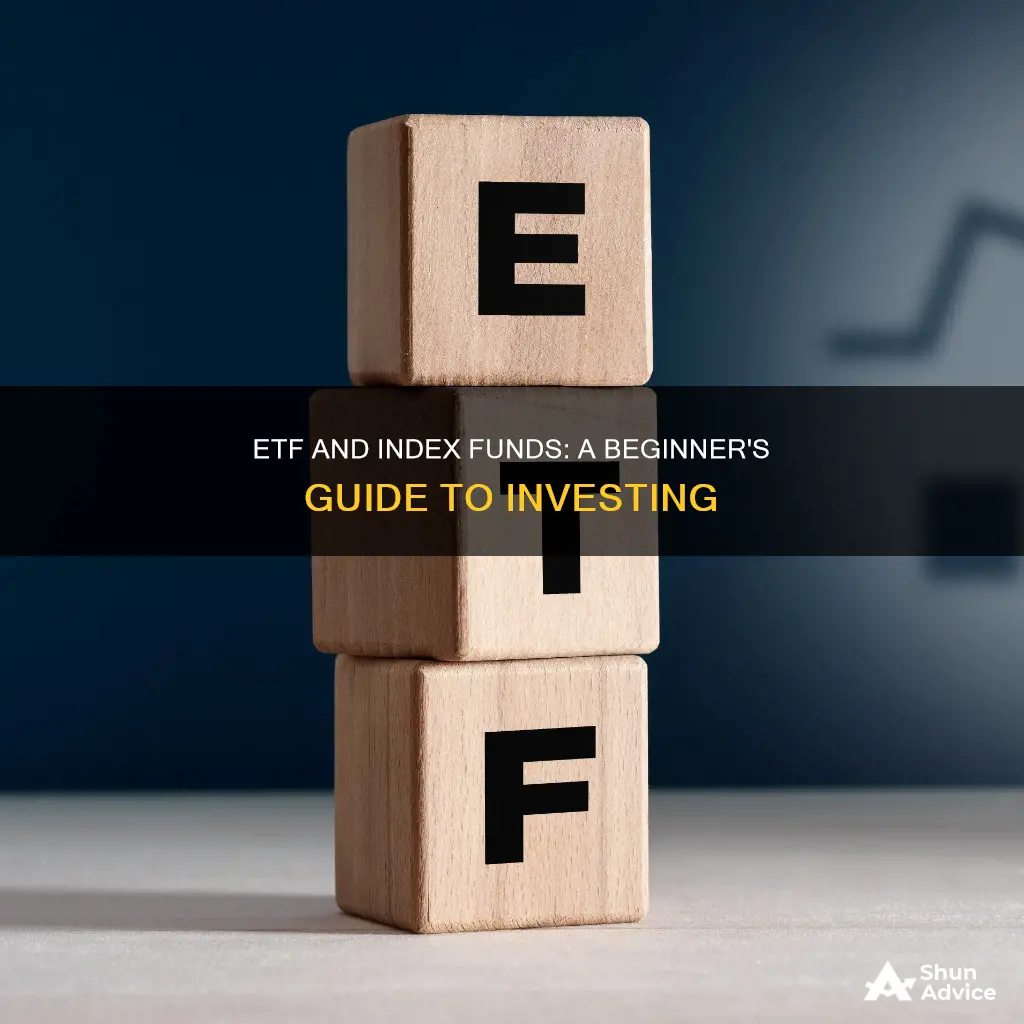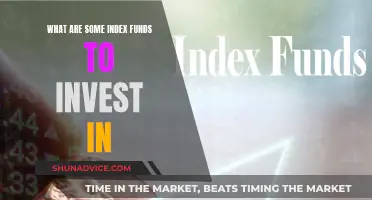
Exchange-traded funds (ETFs) and index funds are a great way to get into the market and achieve diversification. They are a collection of stocks, bonds, and other assets traded like individual stocks on an exchange. ETFs are more flexible than index funds as they are traded during the day, like stocks, whereas index funds are bought and sold when the markets close. ETFs are also considered more tax-efficient compared to traditional mutual funds.
ETFs can be either passive or active. Passively managed ETFs track the performance of a particular index, while actively managed ETFs attempt to outperform a specific benchmark or index.
Index funds are a type of mutual fund or ETF that mirrors the performance of a market index, such as the S&P 500 or the Dow Jones Industrial Average. They are popular among investors who take a passive approach and are focused on the market's long-term growth.
When investing in ETFs, investors should consider the fund's expense ratio, trading costs, fund options, and convenience. For index funds, it is important to consider the fund's long-run performance, expense ratio, trading costs, and fund options.
| Characteristics | Values |
|---|---|
| Type of fund | Exchange-Traded Fund (ETF) or Mutual Fund |
| Investment type | A group of stocks that aims to mirror the performance of an existing stock market index |
| Investment minimum | As low as nothing or as high as a few thousand dollars |
| Account minimum | $0 |
| Expense ratio | Fees that are subtracted from each fund shareholder’s returns as a percentage of their overall investment |
| Tax-cost ratio | Taxes that can take a bite out of investment returns |
| Management | Passive or Active |
What You'll Learn

Understanding the basics of ETFs and index funds
Index funds are a type of mutual fund or exchange-traded fund (ETF) that tracks the performance of a specific market index, such as the S&P 500 or the Dow Jones Industrial Average. They are designed to mirror the underlying index by investing in all the components of that index. Index funds are considered passive investments as they aim to replicate the performance of the index rather than actively selecting stocks.
Benefits of Index Funds
- Low Cost: Index funds have lower fees compared to actively managed funds as they require less active management. Index funds typically have lower expense ratios, which are fees charged as a percentage of the investor's total investment.
- Diversification: Index funds provide instant diversification as they invest in a broad range of companies or assets within a particular index. This reduces the risk associated with investing in individual stocks.
- Long-Term Performance: Historically, major indexes have provided solid returns over the long term. For example, the S&P 500 has averaged an annual return of around 10% over the long term.
Exchange-Traded Funds (ETFs) are investment vehicles that pool a group of securities, such as stocks, bonds, or other assets, into a fund. ETFs can be designed to track a specific index, sector, or investment strategy. They are traded on stock exchanges like individual stocks, offering more flexibility and control to investors.
Benefits of ETFs
- Diversification: ETFs provide instant diversification, allowing investors to gain exposure to a broad range of securities or assets with a single investment.
- Flexibility: ETFs can be traded throughout the day, giving investors more control over their investments.
- Lower Fees: ETFs generally have lower expense ratios and fewer broker commissions compared to buying individual stocks or mutual funds.
- Tax Efficiency: ETFs are considered more tax-efficient than mutual funds as they do not trigger capital gains taxes as frequently due to lower portfolio turnover.
Differences Between ETFs and Index Funds
While both ETFs and index funds offer diversification and can track market indexes, there are some key differences:
- Trading Flexibility: ETFs are traded on stock exchanges during market hours, like individual stocks, offering more flexibility. Index funds, on the other hand, are typically bought and sold when the market closes, similar to mutual funds.
- Fees: ETFs may have lower fees compared to index funds, especially if brokers offer zero-trade commission options. However, index funds typically do not have transaction or commission fees.
- Tax Efficiency: ETFs are generally considered more tax-efficient than index funds, as they do not trigger capital gains taxes as frequently.
Audits: Crucial for Investment Funds' Success and Stability
You may want to see also

How to choose the right fund for your index
- Consider the type of index fund: There are two main types of index funds: mutual funds and exchange-traded funds (ETFs). Mutual funds can be bought directly from the fund house, while ETFs can be bought and sold on the stock exchange and usually require a demat account.
- Look at the fund's performance: Evaluate the fund's rolling returns over different periods to understand how it has performed compared to other indices. For example, the NIFTY NEXT 50 index has offered the highest returns among large-cap indices, but it can be more volatile in the short term.
- Diversification: Choose an index fund that offers a wide array of holdings and invests in liquid securities that are easy to track. This will help to diversify your portfolio and reduce risk.
- Expense ratio: Compare the expense ratios of different index funds, as these fees can eat into your returns over time. Look for funds with low expense ratios, such as the Fidelity ZERO Total Stock Market Fund, which charges no fees.
- Investment objectives: Select an index fund that aligns with your investment goals and risk tolerance. Consider factors such as company size, geography, business sector, asset type, and market opportunities.
- Fund provider: Consider whether the fund provider offers other index funds that you may be interested in using. This can simplify your investment process by allowing you to hold multiple index funds under a single account.
- Tax efficiency: Index funds that don't do a lot of buying and selling of their holdings tend to be more tax-efficient, as they generate fewer capital gains that can add to your tax bill.
- Restrictions: Be aware of any limitations or restrictions on the index fund, such as minimum investment requirements, that may prevent you from investing in it.
Best Low-Risk UK Funds for Conservative Investors
You may want to see also

How to buy shares in an index fund
Index funds are a great investment for building wealth over the long term. They are a group of stocks that mirror the performance of an existing stock market index, such as the Standard & Poor's 500 index. Index funds don't try to beat the market but instead try to be the market by buying stocks of every firm listed on a market index.
- Have a goal for your index funds: Know what you want your money to do for you. If you're looking to make a lot of money in a few years and are willing to take risks, you may be more interested in individual stocks or cryptocurrencies. However, if you want to slowly grow your money over time, especially for retirement, index funds may be a good option.
- Research index funds: Look at the actual index funds you'll be investing in. Consider the company size, geography, business sector, asset type, and market opportunities. You may only need to invest in one broad stock market index, according to investing legend Warren Buffett. However, you can customise your fund mix if you want more exposure to specific markets.
- Pick your index funds: Choose an index fund with low costs that fits your investment objectives. Two funds may have the same investment goal but have vastly different management costs, so it's important to compare.
- Decide where to buy your index funds: You can purchase an index fund directly from a mutual fund company or a brokerage. Consider factors such as fund selection, convenience, trading costs, impact investing, and commission-free options.
- Open an investment account: To purchase shares of an index fund, you'll need an investment account. A brokerage account, individual retirement account (IRA), or Roth IRA will all work.
- Buy the index fund: Go to your broker's website and set up the trade. Input the fund's ticker symbol and the number of shares you want to buy, based on your budget. Many brokers allow you to set up an investing schedule to buy the index fund regularly.
- Keep an eye on your index funds: Monitor your index fund to ensure it's mirroring the performance of the underlying index. Also, watch out for increasing fees, as these can eat into your returns over time.
A Guide to Investing in Canadian Mutual Funds
You may want to see also

The pros and cons of investing in ETFs
Exchange-traded funds (ETFs) are a powerful type of investment that offers certain advantages over other types of investments such as individual stocks or mutual funds. However, there are also some drawbacks to consider. Here are the pros and cons of investing in ETFs:
Pros of investing in ETFs:
- Lower costs: ETFs tend to have lower expense ratios than mutual funds and other types of investments. This is because they are passively managed, meaning they aim to mimic the performance of an index rather than actively trying to beat the market.
- Diversification: ETFs typically offer diversified investments, with some aiming to provide exposure to the total stock market. This helps to reduce risk, as investors are not overly dependent on the performance of a single company or industry.
- Tax efficiency: ETFs are more tax-efficient than mutual funds because they generate fewer capital gains. This is because they are passively managed and do not trade as frequently.
- Trading flexibility: ETFs can be traded throughout the day on exchanges, similar to stocks. This gives investors more control over their investments and allows them to take advantage of market movements.
- Risk management: ETFs offer various risk management opportunities such as market, stop-loss, and limit orders.
- Accessibility: ETFs are accessible to a wide range of investors, from individuals to institutions, and can be used to achieve various financial goals.
Cons of investing in ETFs:
- Trading costs: Buying and selling ETFs incurs trading fees, similar to stocks. These costs depend on the brokerage firm and the type of ETF.
- Limited diversification: In some cases, ETFs might only offer exposure to large-cap stocks within a particular sector or market index. This could limit an investor's growth opportunities.
- Lower returns: While ETFs are less risky than individual stocks, they might also offer lower returns. High-yielding stocks or groups of stocks may provide higher dividend yields than ETFs.
- Not ideal for hands-on investors: ETFs might not be suitable for investors who want more control over their investments or who have specific investment goals or values.
- Partial shares may not be available: Depending on the brokerage firm, investors may not be able to buy partial shares of ETFs, making investing more complicated.
Vanguard Funds: Choosing the Right Investment for You
You may want to see also

How to start investing in ETFs
Exchange-traded funds (ETFs) are a collection of stocks and bonds in a single fund, similar to mutual funds. They are an easy and perfect way for beginners to get started investing. ETFs can generate impressive returns without requiring much expense or effort for investors.
An exchange-traded fund, or ETF, allows investors to buy many stocks or bonds at once. Investors buy shares of ETFs, and the money is used to invest according to a certain objective. ETFs trade just like stocks on major exchanges such as the NYSE and Nasdaq.
Open a brokerage account:
You'll need a brokerage account to buy and sell securities like ETFs. The majority of online brokers now offer commission-free stock and ETF trades, so cost isn't a major consideration. Compare each broker's features and platform. If you're a new investor, it might be a good idea to choose a broker that offers an extensive range of educational features.
Choose your first ETFs:
For beginners, passive index funds are generally the best way to go. Index funds are cheaper than their actively managed counterparts, and most actively managed funds don't beat their benchmark index over time.
Let your ETFs do the hard work for you:
It's important to keep in mind that ETFs are generally designed to be maintenance-free investments. Newer investors tend to have a bad habit of checking their portfolios too often and making emotional, knee-jerk reactions to major market moves. The best advice is to leave them alone and let them do what they're intended to do: produce excellent investment growth over long periods.
Tips for beginners:
- Before investing your hard-earned dollars, try your hand at a practice portfolio to help you better understand the entire investment process. Most online brokers provide practice accounts where you can learn about ETF investing without betting any of your actual savings.
- If you're new to ETF investing, it's important to understand the costs involved, including fees, minimum deposits, and account and transfer fees.
- ETFs are typically passively managed, meaning they attempt to replicate the performance of a specific index.
Mutual Funds: Philippines' Smart Investment Choice
You may want to see also
Frequently asked questions
An index fund is a type of mutual fund or exchange-traded fund (ETF) that tracks a market index, such as the S&P 500 or the Dow Jones Industrial Average. Index funds are designed to mirror the performance of the index they track.
An ETF, or exchange-traded fund, is a collection of stocks, bonds, and other assets that can be traded on an exchange like a stock. ETFs are designed to provide diversification and can be bought and sold at any time during the trading day.
ETFs offer instant diversification, allowing investors to gain exposure to a wide range of assets and sectors. They are also flexible, providing real-time pricing information and the ability to trade during and after market hours. ETFs can be more cost-effective than buying individual assets, and they tend to have lower fees than mutual funds.
When choosing an ETF, consider the underlying assets, the fund's performance, expenses, and the investment minimums. Compare different ETFs to find one that aligns with your investment strategy and goals.







